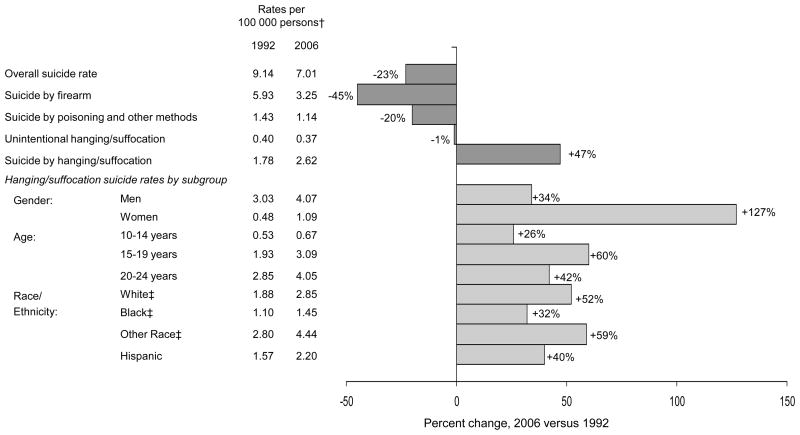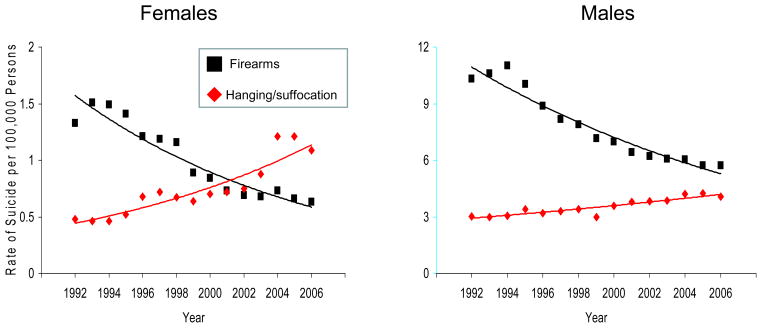Abstract
We examined changes in suicide rates among 10–24-year-olds in the US from 1992–2006. The overall suicide rate and the rate by firearms, poisoning, and other methods declined markedly, whereas the hanging/suffocation rate rose significantly from 1992–2006. This increase occurred across every major demographic subgroup, but was most dramatic for females.
Introduction
The suicide rate among US youth and young adults aged 10 to 24 years has generally declined each year since 1992 except for a sharp rise in 2004 [1]. Recent CDC reports suggest that significant changes have occurred in the methods used for suicide by US youth and young adults, with an increase over time in rates of suicide by hanging/suffocation (i.e., hanging; suffocation by plastic bag; suffocation by unspecified means) and a concomitant decrease in suicide rates by firearms, the most common suicide method in the US [1, 2]. In this brief, we investigate these trends, including the most recent national mortality data available (2005 and 2006), and identify the demographic subgroups at increased risk for suicide by hanging/suffocation.
Methods
Using WISQARS™ (Web-based Injury Statistics Query and Reporting System), we obtained data on deaths for which suicide (coded E950-E959 for International Classification of Diseases, Ninth Revision (ICD-9) [1992–1998] and X60-X84, Y87.0, and *U03 for ICD-10 [1999–2006]) was listed as the underlying cause of death among 10- to-24-year-olds [3]. There is excellent agreement between classification of suicide deaths in ICD-9 and ICD-10 [4]. The 10–24 year age group was selected to facilitate comparison with prior research [1]. The 1992–2006 time period was selected to provide a 15-year context for evaluating recent changes in suicide methods among U.S. youth and young adults. Number and method of suicide per year were extracted for the following demographic subgroups: sex, age (10–14, 15–19, 20–24), and race/ethnicity (non-Hispanic White, non-Hispanic Black, non-Hispanic Other, Hispanic). Crude rates per 100,000 persons were calculated with WISQARS™ population estimates [3]. We also explored trends in deaths due to unintentional hanging/suffocation as a comparator to hanging/suffocation deaths judged to be suicides. The 1992–2006 method-specific trends in annual suicide rates were modeled using negative binomial regression [5]. The Poisson regression model, which assumes that the variance of the residuals around each predicted rate equals the predicted rate, was initially considered for this analysis, but was rejected because of the significant extra-Poisson variability (i.e., overdispersion) [5]. We modeled each method-specific trend using linear and quadratic terms for time. Statistical analyses were performed with Stata Statistical Software: Release 10.1 (StataCorp, College Station, TX).
Results
The regression analysis found that all trends were statistically significant (all p-values≤.01) except for deaths classified as unintentional hanging/suffocation (p>.15). Figure 1 displays the significant decline (−23%) in the overall suicide rate between 1992 and 2006 among persons aged 10–24 years, as well as the significant decreases in suicide rates by firearms (−45%) and by poisoning and other methods (−20%). Hanging/suffocation is the only method of suicide whose rate increased during this period (+47%, p<.001). Suicide by hanging/suffocation increased in every major demographic subgroup, with the largest relative increase in females (+127%). If the suicide rate for hanging/suffocation among all persons aged 10–24 years had remained constant from 1992–2006, the expected number of deaths in 2006 would have been 1,121 compared to the 1,646 observed, an excess of 525 deaths by hanging/suffocation.
FIGURE 1. Percent Change in Rates of Suicide by Method and Rates of Unintentional Hanging/Suffocation in 2006 vs. 1992 for Persons Aged 10 to 24 Years in the United States*.
*All method-specific linear trends based on the negative binomial regression analysis are significant at P<.01 except for the trend in unintentional hanging/suffocation, which was not significant (P>.10).
†For ease of interpretation, crude rates per 100 000 persons are presented using only 1992 and 2006 data points.
‡Non-Hispanic.
Figure 2 displays the rates of suicides by hanging/suffocation and firearms for 10- to 24-year-olds from 1992–2006. Although for males the rate of hanging/suffocation has increased linearly, in females, this rate has increased exponentially. Thus in 2002, hanging/suffocation became the leading method of suicide for females.
FIGURE 2. Annual Suicide Rates by Hanging/Suffocation and Firearms for Females and Males Aged 10 to 24 Years in the United States, 1992 Through 2006.
Red line indicates the trend in the suicide rate by hanging/suffocation and the black line indicates the trend in the suicide rate by firearms. Y-axis intervals shown in blue indicate range from 0 to 12.
Discussion
This study extends prior research on changes in methods of suicide among young persons in the US [1, 2]. While the CDC previously reported an increase from 2003 to 2004 in the suicide rate by hanging/suffocation among females aged 10–24 years [1], we have found significant increases in the rate of hanging/suffocation for US youth and young adults in every major demographic subgroup for the 15-year period from 1992–2006. We could not establish whether the recent increase in suicide by hanging/suffocation is due to hanging, suffocation or both because hanging, strangulation, and suffocation are grouped under a single code in ICD-10, whereas in ICD-9 separate classifications were used.
While reasons for the decline in suicides by firearms, poisoning, and other methods among young people in the US remain unclear, the recent decrease may be related to efforts to restrict access to lethal means [6]. Examples include enactment of youth-focused gun laws [5] and national safe gun storage public awareness campaigns [7]. If the increase in suicide by hanging/suffocation were simply due to youth finding a more easily accessible alternative to firearms, we would have expected to see a corresponding increase in the rate of suicide by poisoning and other methods, which we did not. This suggests that young people in the US are increasingly selecting hanging/suffocation as a method-specific substitution.
While another possible explanation for the increasing trend in the rate of hanging/suffocation suicides in the US could be due to an increase in misclassification of accidental deaths due to, for example, the choking game or auto-erotic asphyxiation, we would have expected to see a corresponding increase in unintentional hanging/suffocation deaths in this age group, which we did not. Furthermore, we have not found evidence in the literature to support this hypothesis.
Even though hanging/suffocation is the leading method of suicide among young people in many countries, including England, Australia, and New Zealand [8], to our knowledge, no study has explored method-specific risk factors for suicide among young people. Efforts must now focus on understanding why young people are increasingly choosing hanging/suffocation as a method of suicide. If modifiable risk factors (psychiatric, psychological, social, circumstantial) [9, 10] can be identified that distinguish young people who die by hanging/suffocation versus other methods of suicide, then more targeted public health interventions could be developed and implemented with the goal of attenuating this alarming trend.
Acknowledgments
Dr. Bridge was supported by grant K01-MH069948 from the National Institute of Mental Health, National Institutes of Health. Drs. Greenhouse and Kelleher were supported by grant 5R01-MH078629-02, Dr. Campo by grant R01-MH069715-04, and Dr. Fabio by grant R49-CCR323155 from the Centers for Disease Control and Prevention. The National Institute of Mental Health and the Centers for Disease Control and Prevention did not participate in the design and conduct of the study, in the collection, analysis, and interpretation of the data, or in the preparation, review, or approval of the manuscript
Footnotes
Publisher's Disclaimer: This is a PDF file of an unedited manuscript that has been accepted for publication. As a service to our customers we are providing this early version of the manuscript. The manuscript will undergo copyediting, typesetting, and review of the resulting proof before it is published in its final citable form. Please note that during the production process errors may be discovered which could affect the content, and all legal disclaimers that apply to the journal pertain.
References
- 1.Lubell KM, Kegler SR, Crosby AE, et al. Suicide trends among youths and young adults aged 10–24 years-United States, 1990–2004. MMWR Morbidity and Mortality Weekly Report. 2007;56:905–908. [PubMed] [Google Scholar]
- 2.Centers for Disease Control and Prevention. Methods of suicide among persons aged 10–19 years--United States, 1992–2001. MMWR Morbidity & Mortality Weekly Report. 2004 Jun 11;53(22):471–474. [PubMed] [Google Scholar]
- 3.Centers for Disease Control and Prevention. National Center for Injury Prevention and Control. Web-based Injury Statistics Query and Reporting System (WISQARS) [online] Source of data from WISQARS is the National Vital Statistics System from the National Center for Health Statistics. 1992–2006 Available from URL: www.cdc.gov/ncipc/wisqars, Last accessed, 10/09/2009.
- 4.Anderson RN, Minino AM, Fingerhut LA, et al. Deaths: injuries, 2001. Natl Vital Stat Rep. 2004;52:1–86. [PubMed] [Google Scholar]
- 5.Webster DW, Vernick JS, Zeoli AM, et al. Association between youth-focused firearm laws and youth suicides. JAMA. 2004;292:594–601. doi: 10.1001/jama.292.5.594. [DOI] [PubMed] [Google Scholar]
- 6.Mann JJ, Apter A, Bertolote J, et al. Suicide prevention strategies: a systematic review. JAMA. 2005 Oct 26;294(16):2064–2074. doi: 10.1001/jama.294.16.2064. [DOI] [PubMed] [Google Scholar]
- 7.The Advertising Council Inc. Through the Eyes of a Child: Safe Gun Storage Campaign Case Study. www.adcouncil.org, Last accessed May 7, 2009.
- 8.Berman AL, Jobes DA, Silverman MM. Adolescent Suicide: Assessment and Intervention. 2. Washington, DC: American Psychological Association; 2006. [Google Scholar]
- 9.Bridge JA, Goldstein TR, Brent DA. Adolescent suicide and suicidal behavior. J Child Psychol Psychiatry. 2006;47(3/4):372–394. doi: 10.1111/j.1469-7610.2006.01615.x. [DOI] [PubMed] [Google Scholar]
- 10.Biddle L, Donovan J, Hawton K, et al. Suicide and the internet. BMJ. 2008;336:800–802. doi: 10.1136/bmj.39525.442674.AD. [DOI] [PMC free article] [PubMed] [Google Scholar]




